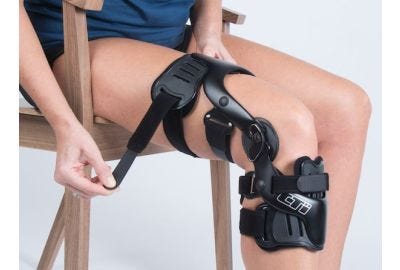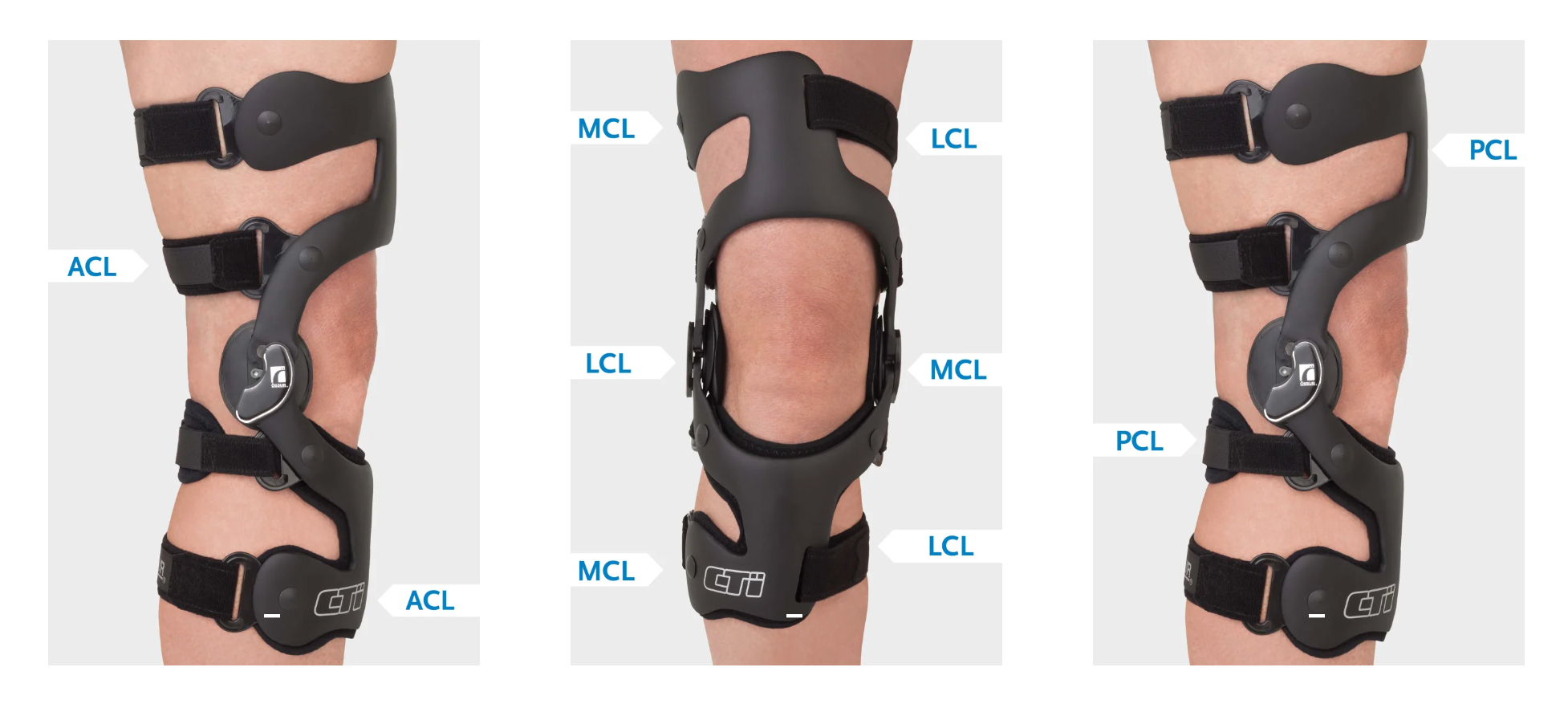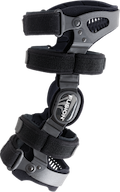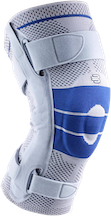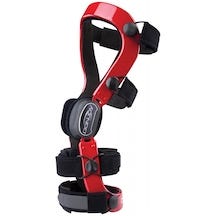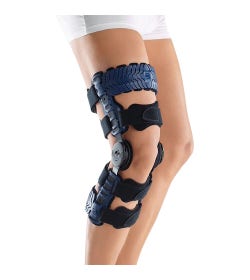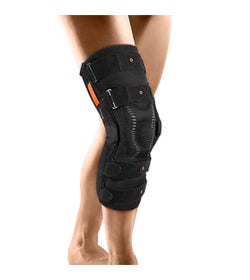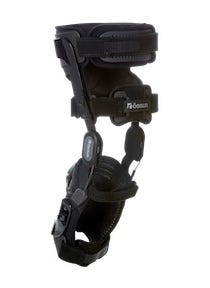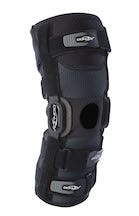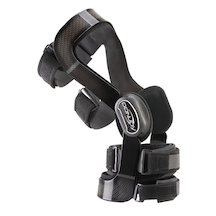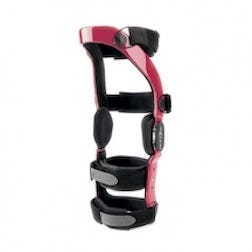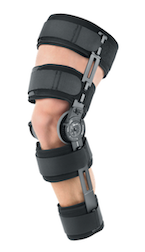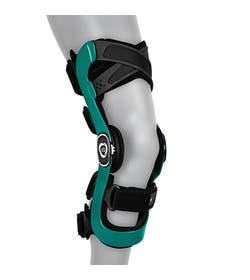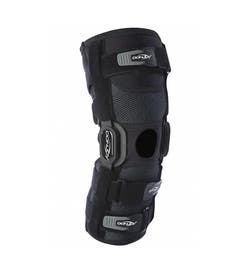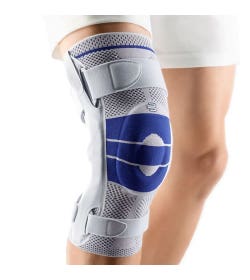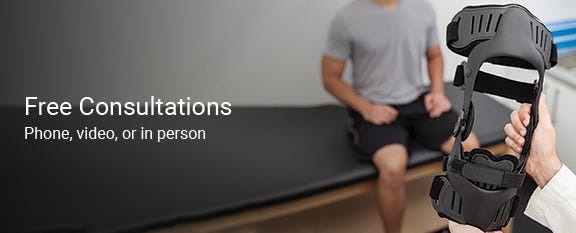What's In This Post
Click to jump to section
- Which Ligament Are You Treating?
- Most common ligament injuries
- Ligament surgery
- How Ligament Braces Work & Types
- Frame design
- Types of hinges used
- Use of compression
- Styles: Hinged, Wrap, Sleeve, ACL, PCL, MCL/LCL, CI, Unloader, ROM...
- Our Top Choices for Ligament Knee Braces
- Most Durable for Sports
- Light Weight, Low Profile
- Casual, Daily Use
- Best Soft Hinged
- Use and Care Tips
- Booking a Consultation
Which Knee Ligament Are You Trying to Protect?
The knee joint is a complex structure comprised of bones, cartilage, ligaments, and tendons that work together to provide stability and facilitate movement. The main ligaments in the knee joint are:
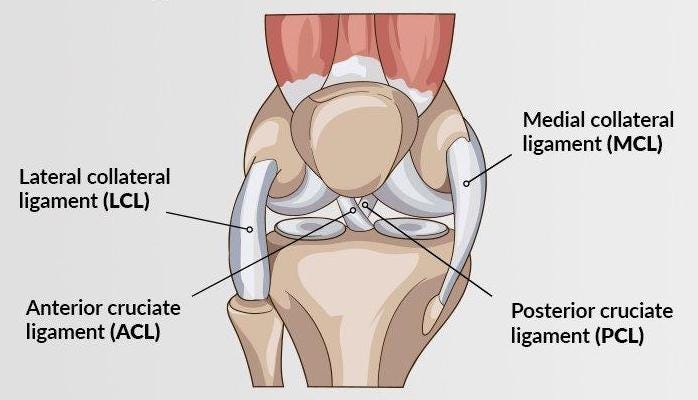

These four ligaments work together to stabilize the knee joint during various activities, such as walking, running, jumping, and changing direction. Injuries to these ligaments, particularly the ACL and MCL, are relatively common, especially in sports that involve rapid changes in direction, sudden stops, or collisions.
- Anterior Cruciate Ligament (ACL): located in the center of the knee and connects the femur (thighbone) to the tibia (shinbone). It prevents the tibia from sliding too far forward and provides rotational stability to the knee.
- Posterior Cruciate Ligament (PCL): also located in the center of the knee, running parallel to the ACL. It connects the femur to the tibia and prevents the tibia from sliding too far backward.
- Medial Collateral Ligament (MCL): located on the inner side of the knee and connects the femur to the tibia. It provides stability against valgus (inward) forces on the knee and helps to prevent excessive side-to-side movement.
- Lateral Collateral Ligament (LCL): located on the outer side of the knee and connects the femur to the fibula (the smaller bone in the lower leg). It provides stability against varus (outward) forces on the knee and helps to prevent excessive side-to-side movement.
The most common types of knee ligament injuries
Severity levels
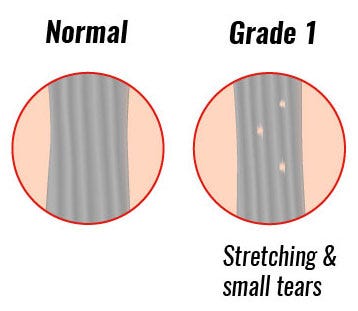

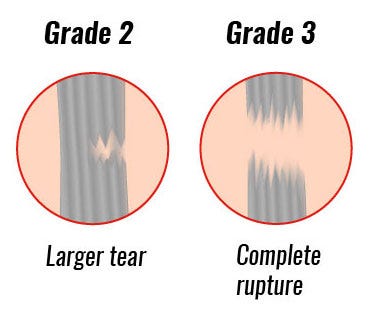

- Grade I (Mild): This grade represents a slight stretching or minor tearing of the ligament fibers. The joint remains stable, and there is minimal pain, swelling, and joint stiffness. Recovery time for a Grade I injury is usually shorter, ranging from a few days to a few weeks, depending on the individual's healing capacity.
- Grade II (Moderate): This grade indicates a partial tear of the ligament, causing moderate pain, swelling, and joint instability. There might be some loss of function, and the joint may feel loose. Recovery from a Grade II injury typically takes longer than a Grade I injury, often requiring several weeks to a few months of rest, rehabilitation, and potentially immobilization with a brace.
- Grade III (Severe): A Grade III injury signifies a complete tear or rupture of the ligament, leading to significant pain, swelling, and joint instability. This grade of injury often results in a loss of function and requires an extended recovery period. Treatment may involve surgery to repair or reconstruct the ligament, followed by a comprehensive rehabilitation program. Recovery time for a Grade III injury can range from several months to a year or more, depending on the specific ligament and the individual's healing capacity.
Ligament injuries are graded based on the severity of the damage to the ligament fibers. There are three grades of ligament injuries, which are as follows:
Types of ligament injuries
Knee ligament injuries are common, particularly among athletes participating in sports that involve sudden stops, rapid changes in direction, or physical contact. The most common types of knee ligament injuries include:
- Anterior Cruciate Ligament (ACL) Injuries: ACL injuries are among the most common knee ligament injuries, often occurring during sports that involve jumping, pivoting, or cutting movements. They can range from mild sprains to complete tears. ACL tears frequently require surgical intervention to restore stability and function to the knee.
- Medial Collateral Ligament (MCL) Injuries: MCL injuries are also common, typically resulting from a force applied to the outer side of the knee, causing the knee to buckle inward (valgus stress). MCL injuries can range from mild sprains to complete tears. Most MCL injuries can be treated non-surgically with bracing and physical therapy, although severe cases may require surgery.
- Posterior Cruciate Ligament (PCL) Injuries: PCL injuries are less common than ACL or MCL injuries. They often occur due to a direct blow to the front of the knee (such as during a car accident) or from landing awkwardly after a jump. PCL injuries can range from mild sprains to complete tears. Depending on the severity, they may be treated with conservative measures or require surgical intervention.
- Lateral Collateral Ligament (LCL) Injuries: LCL injuries are relatively rare compared to other knee ligament injuries. They usually result from a force applied to the inner side of the knee, causing the knee to buckle outward (varus stress). Like the other ligaments, LCL injuries can range from mild sprains to complete tears. Treatment may involve conservative measures or surgery, depending on the severity of the injury.
How do ligament knee braces help an injury?
Ligament knee braces are specifically designed to provide support and stability to the knee joint following a ligament injury. They help alleviate pain, reduce inflammation, and protect the injured ligaments during the healing process. By restricting excessive movement, and protecting against rotational forces and impacts these braces allow the damaged ligaments to recover more effectively.
Ligament surgery
Knee ligament surgery is typically performed to repair or reconstruct torn or damaged ligaments, which provide stability and support to the knee joint. The most common types of knee ligament surgeries include:
- Anterior Cruciate Ligament (ACL) Surgery: This procedure is performed to repair or reconstruct a torn ACL, which is one of the main stabilizing ligaments in the knee. ACL surgery can be done using an autograft (tissue taken from the patient's own body) or an allograft (donor tissue).
Posterior Cruciate Ligament (PCL) Surgery: The PCL is another major ligament in the knee that helps maintain stability. - PCL surgery is less common than ACL surgery, as PCL injuries are less frequent. Similar to ACL surgery, PCL reconstruction involves using an autograft or allograft to replace the damaged ligament.
- Medial Collateral Ligament (MCL) Surgery: MCL injuries are typically treated non-surgically with bracing and physical therapy, but in severe cases or when other ligaments are also injured, MCL surgery may be necessary. MCL surgery can involve repair or reconstruction of the ligament using sutures, anchors, or grafts.
- Lateral Collateral Ligament (LCL) Surgery: LCL injuries are less common than other knee ligament injuries, and like MCL injuries, are often treated non-surgically. In more severe cases, LCL surgery may be performed to repair or reconstruct the damaged ligament using similar techniques as those employed for MCL surgery.
- Multi-Ligament Knee Reconstruction: In cases where multiple ligaments are injured simultaneously, a multi-ligament knee reconstruction may be necessary. This complex surgery involves repairing or reconstructing multiple damaged ligaments to restore knee stability and function.
How do ligament knee braces help following surgery?
Ligament knee braces are also commonly used as part of post-surgical support for individuals who have undergone knee surgery. Following surgery, the knee joint can be vulnerable to further injury or instability, and a knee brace can help provide the necessary support and protection. The type of knee brace used will depend on the specific type of surgery and the degree of instability or weakness present in the joint.
During the recovery process (with the guidance of your surgeon or physiotherapist), you may start with a post-operative knee brace and eventually transition to a ligament knee brace for ongoing daily use. Normally, during the initial stage of rehabilitation the knee will be immobilized in a straight position (using the drop lock feature on the hinge) or limited to a specific range of motion (using a brace with a range of motion hinge). Your range of motion is progressively increased within prescribed parameters (to allow for certain degrees of movement). It's important to work closely with your surgeon and physical therapist to determine the appropriate type of knee brace and usage plan specific to your surgery.
How Do Ligament Knee Braces Work and What are the Different Types?
Frame design
Points of leverage
Ligament knee braces use several 'points of contact' on the leg to achieve their support.
A popular design concept that is called 'four points of leverage' was pioneered by DonJoy, and other manufacturers have their own approaches (such as the Ossur CTi, six points of support concept, and frame design that 'locks' onto the tibia and acts as an exoskeletal support to provide better brace-to-bone contact).
These points of leverage (along with the hinges) are what provide the stability and support to the knee joint: distributing forces across several key areas, thus reducing the load on the injured ligament(s). This approach is particularly useful for managing anterior cruciate ligament (ACL) injuries, as it helps control anterior tibial translation (movement of the tibia forward relative to the femur).
The points of leverage in a ligament knee brace typically include:
- Anterior (above the knee): Applies a downward force on the femur (thigh bone), preventing it from moving forward.
- Posterior tibia (below the knee): Applies a downward force on the tibia, preventing it from moving backward relative to the femur.
- Posterior thigh (above the knee): Applies an upward force on the femur, preventing it from moving backward.
- Anterior tibia (below the knee): Applies an upward force on the tibia (shin bone), preventing it from moving forward relative to the femur.
Both soft and rigid frame braces can be used to help support and protect knee ligaments. The reason that 'rigid frame' braces are recommended for more serious ligament issues is that they are structurally stronger. Their design and more rigid materials used can create more 'leverage', applying a stronger force to various parts of the leg, and therefore allowing them to better control the movement of the knee. The idea of leverage also applies to the 'length' of a knee brace: the shorter a knee brace is the less leverage it can produce, and this limits the amount of knee support.
By applying forces in these four areas, the knee brace effectively stabilizes the joint, protecting the injured ligament and allowing it to heal while reducing the risk of further injury.
Materials used
The rigid components of ligament braces can be constructed of materials like aluminum, carbon fiber, and composite materials. Aluminum is lightweight and strong, providing stability without adding unnecessary bulk. Carbon fiber is a high-performance material valued for its exceptional strength-to-weight ratio, making it ideal for creating sturdy yet lightweight braces. Composite materials, which combine the properties of multiple materials, can be customized to offer a unique blend of strength, flexibility, and weight reduction. Here are some examples:
- Aluminum: DonJoy Armor Knee Brace is a popular example that uses aircraft-grade aluminum to create a strong yet lightweight frame, providing stability and support for athletes and individuals with severe ACL and other ligament injuries.
- Carbon fiber: The Össur CTi Knee Brace is constructed with carbon fiber, delivering a high strength-to-weight ratio for maximum support and durability. This brace is often used by professional athletes, particularly in extreme sports, due to its superior performance and lightweight design.
- Composite materials: DonJoy Defiance and Breg Fusion Knee Braces feature a frame made from composite materials, combining the properties of various materials to create a unique blend of strength, flexibility, and weight reduction. These braces offer reliable ligament protection and stability for individuals with moderate to severe knee instability.
Types of hinges used in Ligament Knee Braces
Hinges in a ligament knee brace serve several important functions to provide stability, support, and protection to the injured knee. These functions include:
- Mimicking the natural motion of the knee: Hinges allow the knee brace to flex and extend, closely replicating the knee's biomechanics. This ensures that the brace moves with the joint, providing support without restricting necessary motion.
- Providing stability: The hinges help stabilize the knee joint by limiting excessive side-to-side (medial-lateral) movements and hyperextension. This added stability is crucial for protecting the injured ligaments and preventing further damage, especially in cases of ligament sprains or tears.
- Load distribution: Hinged knee braces help distribute forces and loads, reducing the stress on the injured ligament(s). This assists in the healing process and helps prevent additional injuries.
- Enhancing proprioception: The presence of hinges in a knee brace can improve proprioception, which is the body's awareness of its position and movement in space. Improved proprioception helps maintain better joint stability and reduces the risk of re-injury.
- Customizable support: Some hinged knee braces offer adjustable hinges, which allow healthcare professionals or the user to limit the range of motion according to the individual's specific needs. This feature can be particularly helpful during the rehabilitation process, as it enables gradual progression towards full range of motion as the ligament heals.
Polycentric Hinge: A polycentric hinge is a multi-axis (rotates around multiple axes or pivot points) hinge that allows for a greater range of motion and flexibility. This type of hinge is often used in dual hinge knee braces and is recommended for individuals with more severe knee injuries or those who require greater support and stability. Polycentric hinges are designed to mimic the natural motion of the knee joint, allowing for greater flexibility and movement.
Pivoting Hinge: A pivoting hinge is a type of multi-axis hinge that allows for rotation and pivoting movements. This type of hinge is often used in knee braces for individuals who engage in sports or activities that require a greater range of motion.
Monoaxial Hinge: A monoaxial hinge is a single-axis (allows movement in only one direction, typically flexion and extension of the knee joint) hinge. This hinge can bend and straighten in a linear motion, but it does not allow for rotation or lateral movement. This type of hinge is recommended for individuals with less severe knee injuries or those who require less support. It is designed to provide rigid support and stability to the knee joint, limiting the range of motion to prevent further injury. While a monoaxial hinge does not allow for as much movement or flexibility as a polycentric hinge, it can be effective in providing targeted support and protection to a specific part of the knee joint.
Off-Set Hinge: An off-set hinge is a hinge that is placed slightly off-center to provide additional support and stability to the knee joint. This type of hinge is often used in knee braces for individuals with medial or lateral ligament injuries. An offset hinge design can be customized to fit the unique contours of an individual's knee, providing a more comfortable and effective fit.
Drop Lock Hinge: A drop lock hinge is a hinge that can be locked in place to prevent movement in a specific direction. This type of hinge is often used in knee braces for individuals with more severe knee instabilities or those recovering from surgery.
Range of Motion (ROM) hinge: has the capability to adjust (in 10 degree increments) the amount of flexion and extension you can perform while wearing the brace. The protocol for adjusting range of motion will depend on the type and severity of the knee injury, as well as the specific surgical procedure performed. This will be prescribed by a surgeon.
The type of hinge used in a ligament knee brace can greatly impact its effectiveness and the level of support it provides. It is also important to consider the quality and durability of the hinge, as well as any adjustment features that may be available to customize the fit and support of the brace. When our Healthcare team assists you in selecting a knee brace we consider the type of hinge design to match your specific needs.
Use of compression
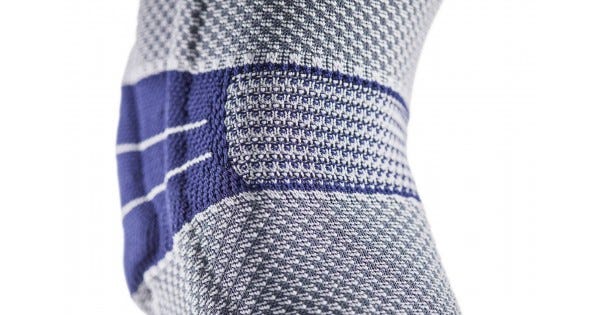

- Swelling reduction: Compression helps control swelling and inflammation by promoting proper blood flow and lymphatic drainage. This can accelerate the healing process and alleviate pain or discomfort associated with an injured ligament.
- Pain relief: Compression provides a gentle, consistent pressure on the soft tissues around the knee, which can help reduce pain by limiting the space for swelling and inflammation. Additionally, it can stimulate the release of endorphins, the body's natural pain relievers.
- Enhanced proprioception: Compression in a knee brace can improve proprioception, which is the body's awareness of joint position and movement. Better proprioception can result in increased joint stability, improved coordination, and a reduced risk of re-injury.
- Support and stabilization: By applying uniform pressure around the knee joint, compression helps support the joint structures, including ligaments, tendons, and muscles. This support can reduce the stress on the injured ligament, promoting healing and preventing further damage.
- Warmth and comfort: Compression materials can provide warmth to the knee joint, which may alleviate stiffness and enhance overall comfort during movement. Warmth can also improve blood circulation, further contributing to the healing process
It's important to note that the level of compression in a ligament knee brace should be adequate to provide support and stability without causing discomfort or restricting blood flow. A healthcare professional can guide you in selecting the appropriate knee brace with the right level of compression for your specific needs.
Most common styles of Ligament Knee Braces
A hinged knee brace is a general category to describe ligament knee braces with hinges (soft as well has rigid frame). If a ligament knee brace is described simply as a 'hinged brace' it is likely an 'off the shelf' version instead of a custom brace. The most common designs include dual hinges, but some have a single hinge. Hinged knee braces can be used for protection of one or multiple ligaments (ACL, MCL/LCL, PCL) depending on the model. They can provide mild, moderate or maximum support and stability for the knee joint: softer flexible braces are better for mild to moderate support, while more rigid frame braces are better for moderate to maximum support. They can be full-frame, sleeve, or wrap-around, and have either metal or plastic hinges. They are helpful for individuals with injuries or those recovering from surgery. custom brace.
A wraparound knee brace is a type of soft hinged knee brace. It is a flexible option that can be easily adjusted to fit a variety of knee sizes. The wrap style also makes this type easier to apply (put on) and remove. It typically features adjustable straps that wrap around the knee, providing support. These braces are designed for mild to moderate support for multiple ligaments.
A knee sleeve is another type of soft hinged knee brace. It is a lightweight and flexible option that is designed to provide mild to moderate support and compression. It is made of stretchy material that fits snugly around the knee, providing warmth and support to the joint. Designed for mild to moderate support of multiple ligaments.
ACL braces are the most common type of ligament protection brace (note many types of braces can be referred to as an 'ACL knee brace'). When you hear ACL brace it is usually a custom measured rigid frame brace with strapping designed specifically to support and stabilize the anterior cruciate ligament (ACL). Sometimes soft hinged knee braces are also referrred to as an ACL brace. ACL knee braces distribute weight and impact forces evenly across the knee joint while restricting rotational movement and helping prevent further injury. Rigid frame designs provide better 'leverage' allowing more control of the knee joint, and protection from harmful movements and impact.
One important consideration with a rigid frame ACL brace is whether you need a custom or off-the-shelf version:
Custom
Custom knee braces are made based on a patient's unique measurements offering personalized support and stabilization. Custom ACL braces are often used following surgery or a severe injury. They are ideal for anyone who will need the brace on an ongoing basis (years), for someone who plays competitive sports or where there is going to be wear and tear on the brace. Custom braces are also important for those with unique anatomy (larger or smaller calves, or thighs) or specific medical conditions, ensuring optimal fit and comfort.
Off the Shelf (Ready made)
Off-the-shelf braces, on the other hand, are available in standard sizes, making them more cost-effective. They are suitable for individuals with mild to moderate ligament injuries, providing general support and protection during daily activities, sports or for lighter usage.
Examples of ACL Knee Braces
There are not many knee braces designed specifically for the PCL. Typically a PCL brace is simply a 'general purpose' hinged ligament brace (soft or rigid frame) or a rigid frame ligament knee brace that is configured specifically for PCL protection (through the selection of a PCL strapping option). Many people will use a brace with combined instability (CI) strapping instead of a brace solely intended for a PCL injury. A PCL knee brace is designed to support and stabilize the posterior cruciate ligament (PCL) in the knee. It may feature a hinge that prevents the knee from bending too far backward.
Support for the MCL/LCL is typically accomplished using a 'general purpose' hinged ligament brace (soft or rigid frame). The brace provides support to the medial collateral ligament (MCL) or lateral collateral ligament (LCL), which are located on the inside and outside of the knee joint, respectively. These braces often feature a single or dual upright hinge and a number of straps to provide support and prevent excessive movements that can cause further damage (to the MCL or LCL). They may also feature an off-set hinge to provide additional support and stability to the affected ligament.
Combined instability braces are usually ligament knee braces with a combined instability (CI) strapping option. They are designed to support multiple ligaments or areas of the knee joint that are affected by instability. They are usually a rigid frame knee brace, with dual hinge design and multiple straps to provide targeted support and prevent excessive movements that can cause further damage. Combined instability braces may also feature an adjustable hinge system to allow for customization and targeted support where it is needed most.
An unloader knee brace is designed to alleviate pain and reduce pressure on a specific part of the knee joint. It typically features a support structure that shifts weight away from the affected area. Unloader knee braces are usually associated with use in treating Osteoarthritis or meniscus tears, however there are situations where unloading the knee joint is done in conjunction with ligament protection. It is quite common to see a meniscus tear with a ligament injury or someone with a previous ligament tear that now has osteoarthritis.
A ROM knee brace (also called a post-operative or post-op ROM brace) is a device used for post-surgical recovery. These braces have rigid metal support bars running down both sides of the leg that are fastened to the leg using Velcro or tension straps. At the knee joint center, the support bars attach to an adjustable post-operative range of motion hinge. The hinge is able to stop movement of the knee entirely, limit the range of motion allowed, or allow movement to occur without restriction (dependent on how the brace is set up). In addition to range of motion control, they are usually length adjustable using a 'telescoping' feature to allow for optimal leverage to immobilize the knee joint. For a more comfortable fit, the metal support bars can typically be bent to better contour to the shape of your leg (this adjustment should be done by a healthcare professional).
Our Choices for Best Ligament Knee Braces
When selecting a ligament knee brace, it's important to choose a high-quality product that will provide the necessary support and protection for your knee joint.
Here are factors that we consider when evaluating the quality of a ligament knee brace and whether it is suitable for you.
- Brand reputation: we look for brands that have a good reputation for producing high-quality, durable knee braces. In our experience the more well-known brands have done the most research and development, and have improved their products using years of real-life customer feedback.
- Material quality: Consider the quality of the materials used to make the brace, including the frame, straps, and hinges. High-quality materials are more likely to be durable and long-lasting. There are many options available from Aluminum or Carbon Fiber to Rigid Plastics.
- Frame and Hinge design: Pay attention to the frame and hinge design of the brace. We look for braces with sturdy, durable hinges that provide the necessary support and stability.
- Strap design: Evaluate the strap design of the brace. Look for braces with adjustable straps that can be customized to provide a snug, secure fit.
- Comfort: Is an important factor when selecting a knee brace. Look for braces with padding or cushioning in key areas to help prevent discomfort or rubbing.
- Fit: A properly fitting brace is essential for effective support and protection. We look for braces that offer a range of sizes and adjustable components to ensure a good fit.
- Testing and certification: Look for braces that have been tested and certified by reputable organizations to ensure they meet the necessary safety and performance standards, in addition to the internal testing done by the manufacturers. Health Canada, Canadian Standards Association (CSA), Food and Drug Administration (FDA), and the American Orthotic & Prosthetic Association (AOPA) are examples of external bodies that may certify or review medical devices. With knee braces they ensure they undergo testing and meet specific standards before they can be sold in the Canadian and US markets.
- What you are going to use the knee brace for: Look for a brace that matches your specific usage needs. We always start by asking our clients about what activities they plan on doing with their brace. Do you need your brace for sports or more for daily use? how much stress are you going to put on your brace? and how durable does it need to be? In addition, we consider each person's age, weight, and height as these factors will also influence what brace is most appropriate.
Our Top Choices for Most Durable Ligament Knee Brace for Sports
OSSUR CTi
Why we like it
- Rigid carbon fiber frame ideal for extreme sports.
- A truly custom brace - Ossur offers more options than any brace design - different liner options, multiple length options, frame adaptations, additional straps, internal or external mounting of D-rings, 3 carbon thickness options and many more options to make your brace exactly what you need.
- Breathable liners coated with bio-inert and silicone reduce migration (slipping down) and skin irritation even when used for water sports.
Other similar options that we also like:
- Ossur CTI OTS
- DonJoy SE-4 Legend
- Ossur CTI3 Ligamentous
DonJoy Defiance
Why we like it
- The 'posterior calf' frame design (back part of the lower leg) allows athletes to wear sports equipment such as a shin pad. This frame style also clears a ski/snowboard boot easily.
- Carbon composite frame on the DonJoy Defiance is light weight and yet extremely durable.
- Replacement parts for DonJoy braces are readily available and easy to order. Even the D-rings are replaceable (which is not the case with all braces).
Other similar options that we also like:
- DonJoy Armor Standard Hinge - ACL or Combined Instability
- DonJoy 4Titude - ACL or PCL / Combined Instability
- DonJoy FullForce - ACL or Combined Instability
Our Top Choices for Lightest Weight / Lowest Profile Ligament Knee Brace
BREG Z12
Why we like it
- Low profile, magnesium frame weighing in at 14 oz. (.4 kg). The Z-12 brace is one of the lightest on the market.
- Quick-release buckles ease application.
- Pivoting gastroc strap design helps minimize brace migration (resists the brace moving from its ideal wearing position on the leg).
- Ideal for non-contact sports.
Other similar options that we also like:
DonJoy A22
Why we like it
- Similar in design to DonJoy's signature brace, the DonJoy Defiance, but made with a titanium frame. Titanium provides 2x the strength of aluminum and 45% lighter than steel.
- Streamlined integration of straps and liners reduces overall profile which facilitates comfort and speed (when running).
- Low profile design with attractive colour scheme makes this a great choice for someone has previously enjoyed the Don Joy Defiance but wants something a little lower profile.
Other similar options that we also like:
- DonJoy Renegade - ACL or PCL / Combined Instability
Our Top Choices for Best Ligament Knee Brace For Casual Use / Daily Comfort
VQ OrthoCare Catalyst Propel
Why we like it
- The patented Active Thigh Cuff (ATC) is a flexible yet durable dual strap thigh cuff system that enables the ultimate in suspension (holding the brace in place) and protection.
- The Active Thigh cuff allows the quadriceps to contract and relax to provide comfort through range of motion but also to minimize muscle atrophy.
- Adjustable ATC allows for future adjustments for weight changes.
Other similar options that we also like:
BREG Fusion
Why we like it
- Contains flexible polymer, which creates a comfortable, precise fit but also allows for minor adjustments with body weight fluctuations.
- High-strength frame design with lightweight, aircraft-grade tempered aluminium.
- Comfortable enough for all day use but strong enough for aggressive sport activity.
Other similar options that we also like:
Our Top Choices for Best General Purpose Soft Hinged Ligament Knee Brace
DonJoy Playmaker II
Why we like it
- The Playmaker II has the same hinge as DonJoy's signature custom ACL brace, the DonJoy Defiance III (called a standard Lo-Pro hinge) which makes this a great option for activities or injuries that do not require a rigid framed brace but still need great support.
- High tenacity nylon/spandex fabric used for the Playmaker II makes this brace more breathable and comfortable to wear than the original Playmaker knee brace.
- Finished rubber ends on the straps make the velcro more durable and easier to open and close.
Other similar options that we also like:
- DonJoy Playmaker II FourcePoint Knee Brace
Bauerfeind GenuTrain S
Why we like it
- Bauerfeind's GenuTrain S knee brace has an extra level of support using side bars and a knee cap insert to guide the knee's movement while keeping the area stable. The knee is stabilized but your mobility is not affected.
- A viscoelastic padded ring keeps the kneecap centered. This produces a massage effect which activates the surrounding muscle tissue and stimulates circulation.
- The GenuTrain S brace combines medical grade compression with massage to reduce swelling, irritation and pain. Your muscle control is improved and your knee receives more support.
Other similar options that we also like:
- Bauerfeind Genutrain S Pro Knee Brace
Tips for Using and Taking Care of a Ligament Knee Brace
Using a ligament knee brace can be an effective way to support and protect your knee joint while recovering from an injury or managing instability. Here are some tips for using a ligament knee brace effectively:
Wear the brace as directed: Follow the instructions provided by your doctor or physical therapist for when and how to wear the brace. Wearing the brace at the appropriate times and in the correct way can help optimize its effectiveness.
Check the fit: Make sure the brace fits properly and is adjusted correctly. A poorly fitting brace can be uncomfortable and may not provide the necessary support. If you think your brace isn't fitting well contact us and we would be happy to provide our opinion.
Gradually increase usage: Start by wearing the brace for shorter periods of time and gradually increase usage over time as your knee becomes stronger and more stable.
Exercise regularly: Regular exercise and physical therapy can help improve the strength and stability of your knee joint. Consult with your doctor or physical therapist to develop an appropriate exercise program that complements the use of your knee brace.
Don't rely solely on the brace: While a knee brace can provide support and protection, it is not a substitute for proper medical care, exercise, and rehabilitation.
Wash the soft goods (removable straps, pads, etc.) of your brace as needed.
Replace soft goods if the velcro is no longer sticking or the padding has become worn. This will help extend the life of your brace dramatically. Take a look at replacement parts that are available, or contact us if you need anything!
Regularly inspect the brace: Check the brace regularly for signs of wear or damage, such as frayed straps or cracked hinges. If you notice any issues, contact us about repairs or replacement parts.
Get Advice - Book a Consultation
OrthoMed has an experienced team that is ready to assist you with selecting the right brace design, brand and model for your unique needs. If you have a diagnostic report or diagnosis from your doctor we can use that information to assist us in recommending specific knee braces that may be the best fit for your condition

